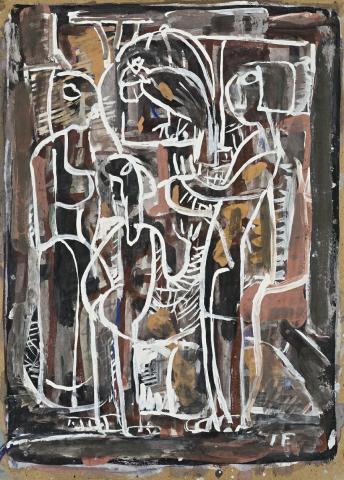BIRDCAGE, 1955
IAN FAIRWEATHER
gouache on card
53.5 x 38.0 cm
signed with initials lower right: IF
bears inscription of title on Peter Bray Gallery label verso
Peter Bray Gallery, Melbourne (label attached verso)
Professor and Mrs Robert A Samek, Niagara Galleries, Melbourne
Private collection, Melbourne
Deutscher~Menzies, Melbourne, 29 August 2002, lot 33
Private collection, New South Wales
Drawing Exhibition, Macquarie Galleries, Sydney, 1955, cat. 15
Ian Fairweather, Peter Bray Gallery, Melbourne, 23 April – 3 May 1956, cat. 11 (label attached verso)
Ian Fairweather and Emily Kame Kngwarreye, Niagara Galleries, Melbourne, January 1995, cat. 3
Bail, M., Ian Fairweather, Bay Books, Sydney, 1981, p. 114 (illus.)
Bail, M., Ian Fairweather, Murdoch Books, Sydney, 2009, p. 112 (illus.)
Family and Bird, 1955, gouache on cardboard, 50.2 x 35.6 cm, illus. in Bail, M., Ian Fairweather, Murdoch Books, Sydney, 2009, p. 112
While white calligraphy may define images, Ian Fairweather's Birdcage, 1955 balances figuration and abstraction with a bravura that inveigles the eye and mind to enjoy its pleasures. The paintwork is lively, of surface play and inviting depths. Moreover, the creative flow is captivating in its synthesis of a lifetime of influences - of Western, Eastern and Aboriginal - of the likeness of gouache to ochre. Frequently Fairweather touches on the harmony of the universal, invoking contemplation and wonder. Exhibited at the Macquarie Galleries in May 1955, the seventeen gouaches painted at Bribie Island included the related Family and Bird, 1955 in the collection of Philip Bacon, Brisbane, and the Cubist head of Aboriginal influences, Sirius, 1955 in the Art Gallery of New South Wales, Sydney. The interest in Aboriginal art is likewise apparent in other works exhibited such as Kangaroo Hunt, 1955 in the Art Gallery of South Australia, Adelaide, the subject of a kangaroo defending her joey from dogs having a biographical genesis as pointed out by Murray Bail.1 Reviewing the exhibition, the art critic for The Sydney Morning Herald wrote - 'This positive quality which dominates his calligraphy plunges into the very heart of the idea, a vibrant emblem of native origin.' He continued, remarking, 'Here is the only painter in Australia who has used the aboriginal idiom without falling into the usual trap of pedantic derivation.'2 Concluding on a note of 'magnificence', he described Mother and Child as 'absolutely original in its expression.'
Considering Birdcage and its companion Family and Bird among the 'white line experiments' of such 1954 paintings as Talking (Roger Benjamin, Sydney) and Pattern (formerly the collection of Tony Tuckson), Murray Bail wrote - 'Fragmentation and cluster become structured, boxed-in, in two separate studies of the one family with an exotic bird ...'3 The visual richness of the outcome of these paintings speaks of their originality arising out of the influences Fairweather had drawn upon. Of his 1958 Melbourne exhibition, Allan McCulloch noted that '... Fairweather is probably the only painter to get anything important from the influence of Australian aboriginal art.'4 Although the Aboriginal influences of x-ray figures and features from bark painting were brief, they did reappear occasionally as in the triumphal Allelujah, 1958, National Gallery of Victoria, Melbourne. Fairweather's constant subject is people, not individuals, but individually seen, as in Birdcage. Said Laurie Thomas, gallery director and friend, 'He paints what he sees. But what he sees nobody else had seen until now.'5
1. Bail, M., Fairweather, Murdoch Books, Sydney, 2009, p. 130
2. 'Power In Two Display', Sydney Morning Herald, 4 May 1955, p. 2
3. Bail, op. cit., p. 122
4. McCulloch, A., Herald, Melbourne, 20 August 1958
5. Thomas, L., 'Ian Fairweather', Art and Australia, Sydney, vol. 1, no. 1, May 1963, p. 35
DAVID THOMAS
